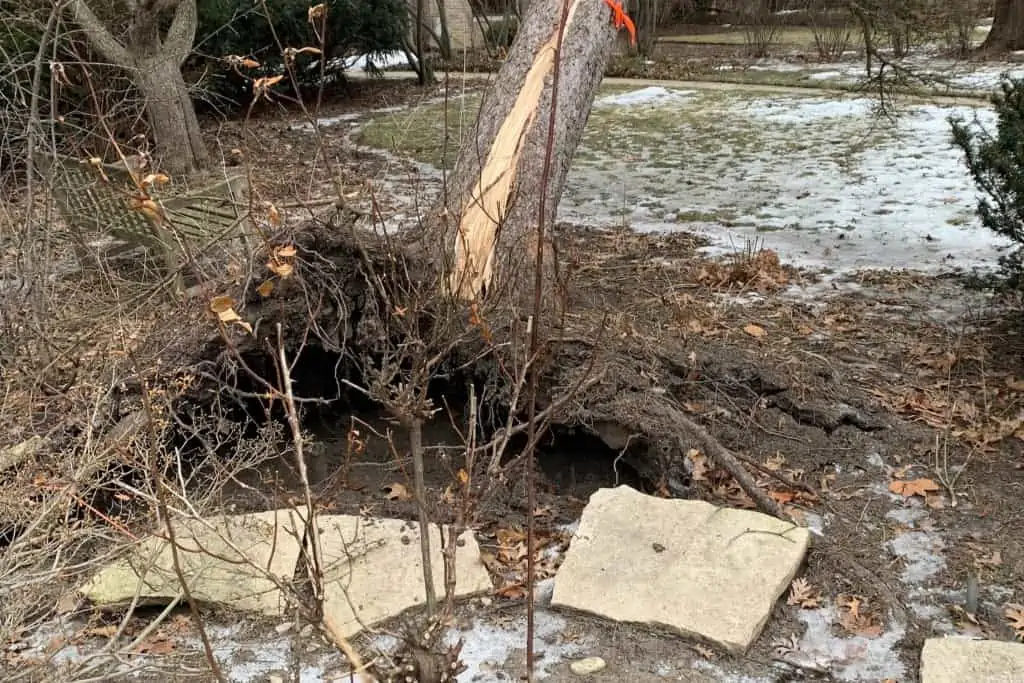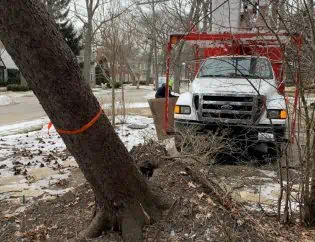
First and foremost, a leaning tree after a storm might represent an imminent hazard, so your first concern should be to keep yourself, your family and your neighbors safe. If unsure, please give us a call at (847) 530-1533
Trees on a property are not just great to look at but also gift the property with multiple benefits. A tree next to a home or close to an outdoor garage provides much-needed shade during the sunny months and greatly aids in reducing cooling expenses. Yet a tree could be a reason for concern when its very existence poses a risk to the safety of property, and people.
Get A Leaning Tree Inspection
If you notice that your tree has started to lean, you need to get worried. This, of course, is not to say that all leaning trees are a risk. On the contrary, there are leaning trees that might pose no threat. For your peace of mind, the best course of action to take with all such trees is to seek advice from a tree professional.
Are Leaning Trees Risky?
The short answer is yes. If the lean is something that happened recently, over a short period of time, that might mean that something has happened to its root system, which gives the tree both sustenance and support.
Should you have a tree leaning towards your home and especially the bedroom, you might have a strong feeling to get the tree removed as you worry about what might happen in the event of a windstorm. As usually happens during times of inclement weather, limbs, or even the entire tree could come down, causing extensive damage and even fatalities.
A similar scenario can be envisaged when the tree leans towards your neighbor’s property. Should the worst happen, it opens you to the risk of litigation from the affected neighbors, and this could prove quite expensive.
Even with such critical considerations, should you condemn a tree for removal simply because it’s leaning? Are there situations when a leaning tree might pose no risk? To answer these questions, it is essential to find out why trees lean.
At the outset, it is essential to remember that professional tree removal is an expense you might not have planned for, especially where you are dealing with a huge tree that is close to the property. Amateur or DIY tree removal in such situations will not do as the untrained person can cause even more property damage in an attempt to bring the tree down. Large trees close to a structure will usually need to be dismantled in sections to keep the property safe, and the skills and tools required might be beyond the reach of an amateur.
Why Trees Lean
Before calling your tree removal company in Evanston and instructing them to bring a tree down, it’d help to find out why your tree is leaning in the first place. Two main factors lead to the leaning of trees and knowing what causes a lean will help you decide on the action to take.
First, a tree will lean from the beginning when it is surrounded by other trees or grows next to a structure that limits the amount of sunshine that the tree receives. The tree will then bend in the direction of the sun, and this will lead to a natural lean. Trees growing in this way are usually safe because right from the beginning, the tree develops a root structure that helps the tree to get a firm grasp on the soil. If your tree then started leaning when it was very young, you might have no reason to get overly concerned about its safety.
A leaning tree that should worry you is one where the tree begins to lean at an older age. Although this is not very common, it does happen and usually it happens after a windstorm. What happens is that the tree could have been partly pulled from the soil, meaning that some of its roots could no longer be functional. This causes the tree to lean as it lacks proper support.
In the event of a subsequent windstorm, there are very high chances that such a tree could tumble down, and it might therefore be prudent to get it removed. Before condemning the tree for removal, you can get the tree inspected. Such an inspection will show if there are any uprooted or broken roots that could make the tree to break or even get uprooted. However, this inspection needs to happen as fast as the actual intervention, because of the possibility of hidden hazards, such a shifting center of gravity, exposed power lines covered by the branches, etc.
Can leaning trees be saved?
If the root system has not been affected too much, some measures can be taken to restore them or allow them to thrive while they are still leaning. And the best way is by cabling the tree. This gives it the support that it needs to bear its weight and that of its branches. Consequentially, your tree will be able to withstand any severe windstorms or such phenomena, so you don’t have to worry about the tree causing damage, even in winter.. However, this is a decision that can be taken after a thorough inspection by a certified arborist.


